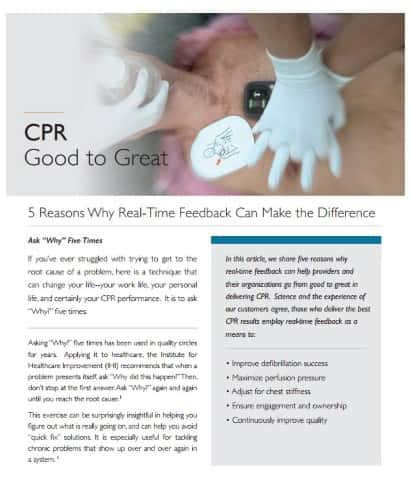You cannot improve that what you cannot measure.
1:27
The consensus is clear: high-quality CPR saves lives,1,2 but when seconds and millimeters can be the difference, even seasoned professionals can have difficulty achieving correct compressions on look and feel alone.
Fortunately, multiple studies3,4 have shown that real-time feedback can improve the quality of compressions provided. As the Resuscitation Academy's Mike Helbock states below, "You cannot improve that what you cannot measure," meaning if your goal is to optimize performance, performance feedback becomes a necessity.
Five experts share their thoughts on the role of using real-time feedback devices in improving survival from cardiac arrest.
Getting healthcare providers to do Guidelines compressions is difficult, and you really need some sort of feedback device to know how fast your rate is or how deep your depth is. At our institution, we’re starting to use more and more of these devices, because we know that healthcare providers can’t do Guidelines CPR quality not because they can’t, but because they just don’t know what 2 inches of depth is without some sort of feedback.
All of us should be measuring our performance in CPR. … We have a range in which we need to stay between in order to optimize outcomes for our patients. We need to be able to measure that, in real time, get real-time feedback, as well as measure our outcomes in our own communities and know what our performance is, so that we can identify issues, optimize care, and identify problems and change them.
It keeps us honest, is the bottom line. … It tells us if our compressions are too deep or if our timing is off or anything like that, so we’re constantly working at using that feedback. You train people how to do the best possible CPR, and doing it with feedback devices is critical because it gives you a good model of how to do as perfect CPR as you can get.
Monitoring and feedback for CPR, I think in a way, that’s the most important thing for EMS providers, for in-hospital providers. … Max Harry Weil, who invented ICU, said, ‘Not using CPR feedback during a code is like a pilot not using GPS while they’re flying a plane.’” … For healthcare providers, I think it’s absolutely essential that we have specific feedback on quality of CPR. That’s extremely important in training.
We are really firm believers of being able to provide feedback to individuals when they go through their training. Being able to provide them with that immediate feedback about what their compression rate and depth is, is really integral in the education process. It helps people to really understand where their deficits are and what they can improve upon. It’s something that’s very important, and hopefully will be able to be integrated in future subsequent educational iterations.

In this article, we share five reasons why real-time feedback can help providers and their organizations go from good to great in delivering CPR.

This infographic provides five impactful facts to help you make the case for implementing real-time feedback during CPR.
The five facts cover:
1) Quality compressions and defibrillation success
2) Patient chest stiffness variance
3) AHA recommendation
4) What's better, visual or auditory feedback?
5) Study results: CPR with feedback vs blind CPR